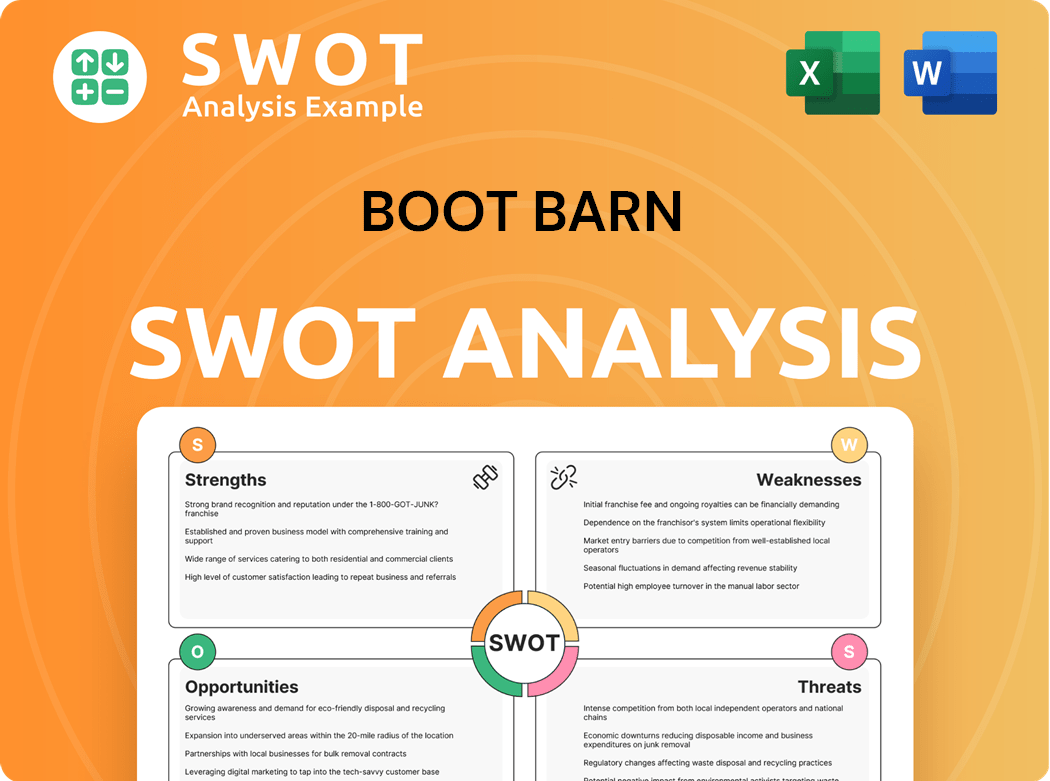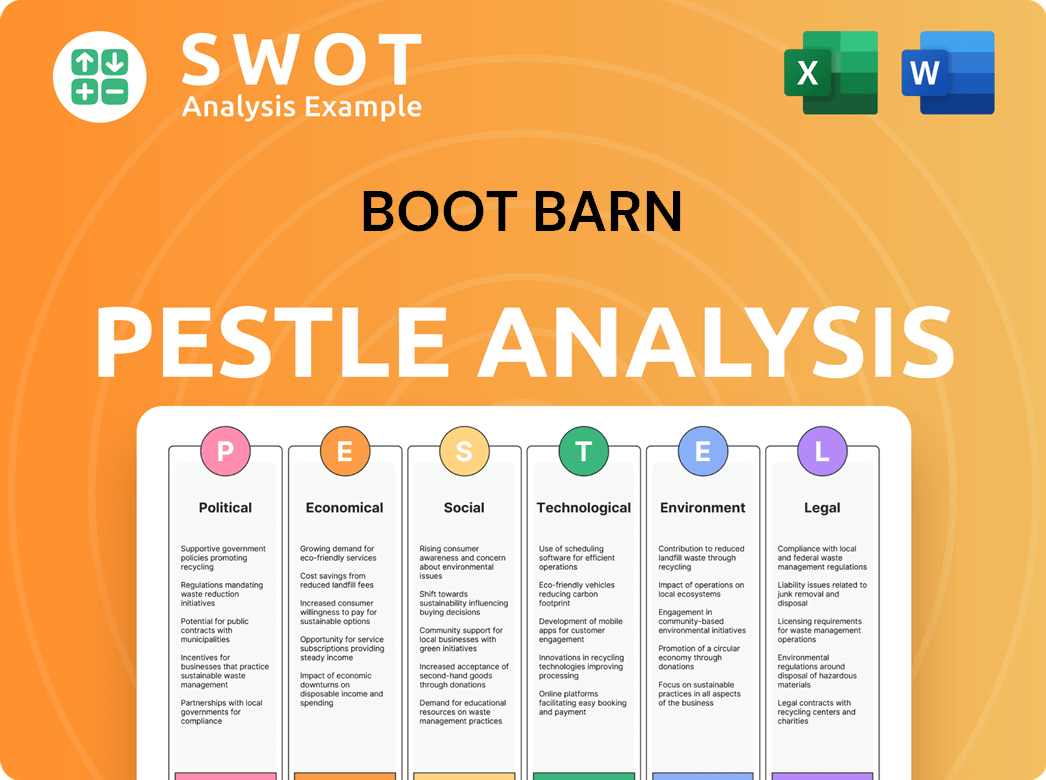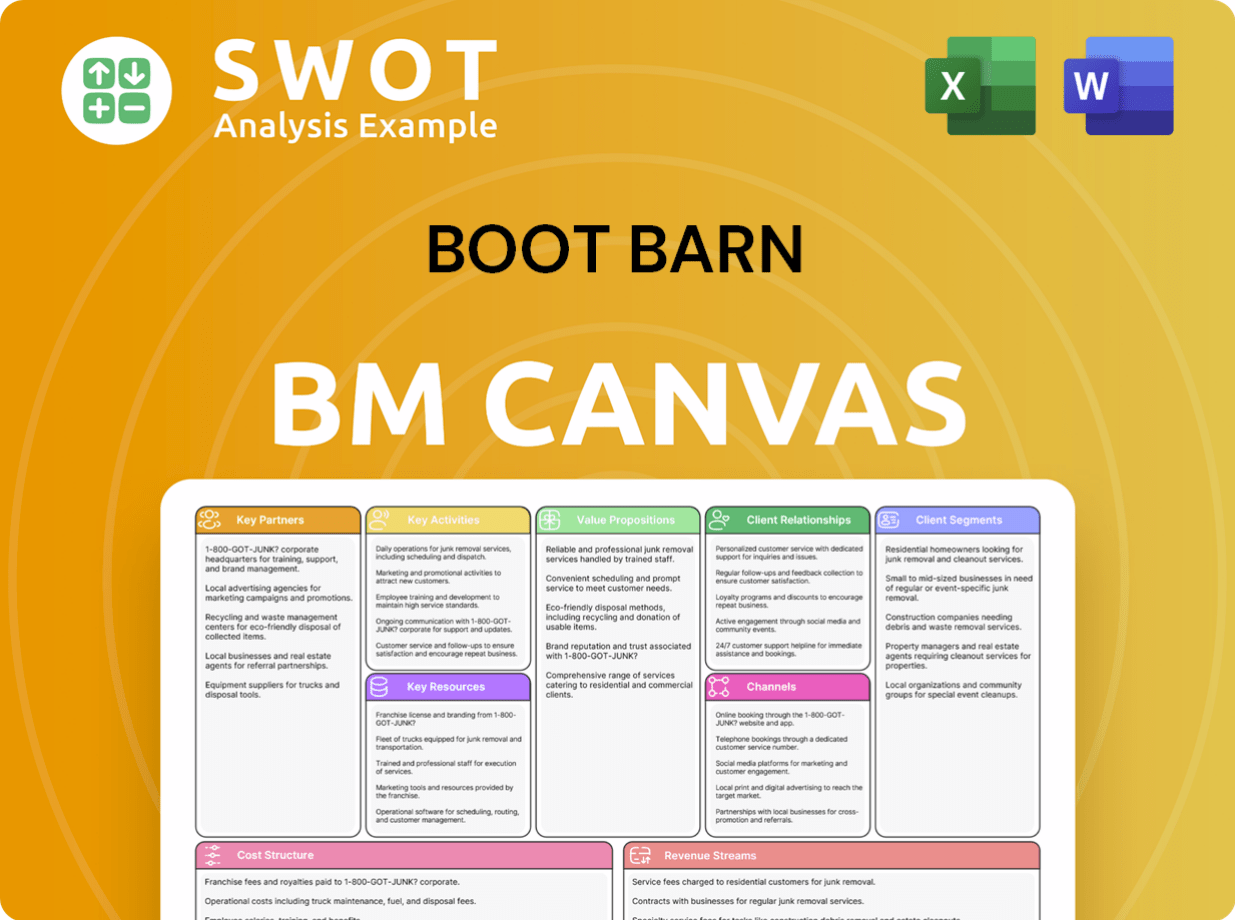Boot Barn Bundle
Can Boot Barn Continue Its Impressive Growth Trajectory?
Boot Barn Holdings, Inc. has become a prominent player in the retail sector, particularly within the western and workwear markets. Its strategic acquisition of Sheplers, Inc. in 2015 was a pivotal move, significantly broadening its market presence. This article delves into Boot Barn's journey, exploring its Boot Barn SWOT Analysis and future prospects.

From its humble beginnings in California in 1978, Boot Barn has expanded to over 400 stores across the United States, becoming the largest western and workwear retailer. This remarkable growth highlights the effectiveness of its business model and its ability to adapt to evolving retail industry trends. This Boot Barn company analysis will examine its Boot Barn growth strategy and how it plans to maintain its leadership position by focusing on Boot Barn future prospects, including its expansion plans for 2024 and beyond, and navigating the competitive landscape within the western wear market.
How Is Boot Barn Expanding Its Reach?
The Boot Barn growth strategy hinges on aggressive expansion and strategic diversification. The company is actively broadening its physical footprint and product offerings to capitalize on opportunities within the retail industry trends.
A primary focus is opening new stores in underserved markets, with a long-term goal of reaching approximately 900 stores across the United States. This expansion is supported by a deep understanding of its customer base, including ranchers, farmers, and those embracing a western lifestyle, which informs strategic location choices.
In fiscal year 2024, the company opened 47 new stores, demonstrating its commitment to this growth strategy. This expansion is not just about increasing the number of stores, but also about optimizing the retail experience to enhance customer satisfaction and drive long-term growth.
The company targets states with limited presence, aligning with its core demographic. This targeted approach allows for efficient resource allocation and market penetration. The focus is on identifying locations that resonate with the western wear market and workwear segments.
Boot Barn is expanding its exclusive brand offerings to differentiate itself from competitors. This strategy aims to improve profit margins and cater to evolving customer preferences. Exclusive brands accounted for 33.3% of net sales in the third quarter of fiscal year 2024.
The company curates product assortments within existing stores to cater to local preferences and emerging trends. This localized approach optimizes inventory and enhances customer satisfaction. This strategy supports the company's long-term growth objectives, ensuring relevance.
Boot Barn continues to invest in its e-commerce platform to enhance online sales. The company's e-commerce strategy is vital for reaching a broader customer base and providing a seamless shopping experience. This includes improving website functionality and expanding online product offerings.
The company's expansion initiatives are designed to drive sustainable growth and increase market share. These initiatives are supported by data-driven decision-making and a focus on customer satisfaction.
- New Store Openings: Continuing to open new stores in strategic locations.
- Exclusive Brands: Expanding the range and availability of exclusive brands.
- Localized Assortments: Tailoring product selections to local market demands.
- E-commerce Growth: Enhancing online sales channels and customer experience.
Boot Barn SWOT Analysis
- Complete SWOT Breakdown
- Fully Customizable
- Editable in Excel & Word
- Professional Formatting
- Investor-Ready Format

How Does Boot Barn Invest in Innovation?
The company is actively embracing innovation and technology to boost its operational efficiency, improve customer experience, and maintain its growth trajectory. This strategic focus is crucial for navigating the dynamic retail industry trends and securing a strong position in the Western wear market. Investments in digital transformation and data analytics are key components of their strategy.
The company's approach includes a strong emphasis on enhancing its omnichannel capabilities. This involves seamlessly integrating the in-store and online shopping experiences to provide customers with a cohesive and convenient shopping journey. The company also focuses on leveraging data analytics to gain insights into customer behavior and optimize its product assortments.
The company is also exploring cutting-edge technologies, such as AI, to streamline operations and reduce costs. This data-driven approach helps the company identify emerging trends and optimize its product assortments. The company's focus on technology extends to its in-store experience, with investments in point-of-sale systems and other tools that enhance customer service and operational efficiency.
The company is heavily investing in digital transformation to strengthen its omnichannel capabilities. This includes optimizing its e-commerce platform to provide a seamless online shopping experience. The goal is to meet the evolving demands of customers who expect a smooth transition between in-store and online shopping.
The company is focused on enhancing its e-commerce platform, which has shown significant growth. Online sales represented 12.8% of total sales in the third quarter of fiscal year 2024. This optimization includes improving website performance, enhancing user experience, and expanding online product offerings.
The company utilizes data analytics to understand customer behavior and personalize marketing efforts. This data-driven approach allows for more effective inventory management and the identification of emerging trends. This helps to optimize product assortments and cater to customer preferences.
The company is exploring the use of AI for inventory forecasting and supply chain optimization. This includes evaluating cutting-edge technologies to streamline operations, reduce costs, and improve overall efficiency. The integration of AI is aimed at enhancing decision-making processes.
Investments in point-of-sale systems and other tools are being made to improve customer service and operational efficiency in stores. These enhancements aim to create a more seamless and efficient shopping experience for customers. This also includes improving the overall in-store environment.
The company's consistent investment in its digital infrastructure and operational technology underscores its commitment to leveraging innovation. This focus supports its ambitious growth targets and helps maintain a competitive edge in the market. The company's strategy is geared towards sustained growth.
The company's innovation strategy is multifaceted, focusing on digital transformation, data analytics, and AI integration. These initiatives aim to boost operational efficiency, enhance customer experience, and drive growth. The company's approach is designed to adapt to the changing retail landscape.
- Omnichannel Integration: Seamlessly merging in-store and online experiences.
- E-commerce Optimization: Improving the online platform to drive sales and enhance user experience.
- Data Analytics: Using data to understand customer behavior, personalize marketing, and optimize inventory.
- AI Implementation: Exploring AI for inventory forecasting and supply chain improvements.
- In-Store Technology: Enhancing point-of-sale systems and other tools for better customer service.
For more information on the company's origins and early strategies, you can refer to Brief History of Boot Barn.
Boot Barn PESTLE Analysis
- Covers All 6 PESTLE Categories
- No Research Needed – Save Hours of Work
- Built by Experts, Trusted by Consultants
- Instant Download, Ready to Use
- 100% Editable, Fully Customizable

What Is Boot Barn’s Growth Forecast?
The financial outlook for Boot Barn appears promising, underpinned by consistent revenue growth and a strategic focus on expansion. A comprehensive Boot Barn company analysis reveals a strong performance in the retail sector. The company's financial health is reflected in its ability to maintain healthy margins and generate robust cash flow, which supports its growth initiatives.
For the third quarter of fiscal year 2024, the company reported net sales of $521.2 million, marking a 4.9% increase compared to the previous year. This growth trajectory is a key indicator of the effectiveness of the Boot Barn growth strategy. The company's commitment to strategic initiatives, including exclusive brands, has positively impacted its financial performance.
In the third quarter of fiscal year 2024, Boot Barn's net income reached $60.5 million, with diluted earnings per share of $1.99. The company's gross profit margin stood at 35.8% during the same period. These figures demonstrate the company's ability to manage costs and maintain profitability in the competitive Western wear market. Further insights into the company's marketing and advertising strategies can be found in the Marketing Strategy of Boot Barn.
Boot Barn has demonstrated strong financial performance, with net sales of $521.2 million in the third quarter of fiscal year 2024. This represents a 4.9% increase year-over-year, showcasing the company's ability to drive revenue growth. The company's strategic initiatives contribute to its financial success.
The company's net income for the third quarter of fiscal year 2024 was $60.5 million, with diluted earnings per share of $1.99. Boot Barn's gross profit margin was 35.8% during the same period. These figures highlight the company's ability to maintain healthy margins.
Boot Barn has provided guidance for fiscal year 2024, projecting net sales to be between $1.673 billion and $1.683 billion. The company anticipates diluted earnings per share to be between $5.38 and $5.48. This guidance reflects the company's confidence in its expansion strategy.
Boot Barn's strategic focus on exclusive brands has contributed positively to its margins. The company's expansion plans, including new store openings, are supported by strong cash flow from operations. These initiatives are key components of the company's growth strategy.
Boot Barn's financial performance is supported by several key metrics that indicate its strength in the retail industry. The company's ability to manage costs and drive sales growth positions it favorably for sustained long-term growth. The following points summarize the key financial aspects:
- Net Sales (Q3 FY24): $521.2 million, a 4.9% increase year-over-year.
- Net Income (Q3 FY24): $60.5 million.
- Diluted Earnings Per Share (Q3 FY24): $1.99.
- Gross Profit Margin (Q3 FY24): 35.8%.
- Projected Net Sales (FY24): Between $1.673 billion and $1.683 billion.
- Projected Diluted EPS (FY24): Between $5.38 and $5.48.
Boot Barn Business Model Canvas
- Complete 9-Block Business Model Canvas
- Effortlessly Communicate Your Business Strategy
- Investor-Ready BMC Format
- 100% Editable and Customizable
- Clear and Structured Layout

What Risks Could Slow Boot Barn’s Growth?
Analyzing the potential risks and obstacles is crucial for understanding the Boot Barn company analysis. Despite its impressive growth, several factors could hinder its future success. These challenges range from market competition to shifts in consumer behavior and supply chain disruptions.
The retail industry trends and the western wear market are subject to change, which can impact the company. Economic fluctuations and evolving consumer preferences also pose significant risks. Boot Barn must navigate these obstacles to maintain its growth trajectory.
Several factors could impact Boot Barn's future ambitions. Market competition, economic downturns, supply chain vulnerabilities, and shifts in consumer preferences are key considerations. Regulatory changes and the rise of e-commerce also pose challenges.
Boot Barn faces intense competition from large general merchandise retailers and smaller specialty stores. These competitors vie for market share in the western and workwear segments. The competitive landscape requires continuous adaptation and strategic initiatives.
Economic downturns or shifts in consumer spending habits could impact sales. Given the discretionary nature of some product offerings, a decrease in consumer spending can significantly affect financial performance. Careful financial planning is essential.
Disruptions in manufacturing or logistics can lead to inventory shortages or increased costs. Supply chain management is critical for maintaining profitability and meeting customer demand. Robust systems are needed to mitigate these risks.
Relying on a specific niche market, like western or workwear, can be risky if trends decline. Shifts in demographics or consumer preferences for sustainable products could also pose challenges. Diversification is a key strategy.
Changes related to labor, trade, or product safety could impose additional costs. Compliance with regulations requires ongoing investment and operational adjustments. Staying informed about regulatory updates is crucial.
Increased online competition from pure-play e-commerce retailers is a growing threat. Developing a robust e-commerce strategy and enhancing online presence are vital for staying competitive. Adapting to digital trends is essential.
To mitigate these risks, Boot Barn employs various strategies. These include diversifying product offerings, maintaining strong supplier relationships, and implementing robust inventory management. Scenario planning helps assess potential economic shifts. The company has demonstrated resilience in navigating past challenges, such as pandemic-related disruptions. Emerging risks like increased online competition and evolving consumer preferences will continue to shape its future trajectory. As of early 2024, the company is focused on expanding its e-commerce capabilities and enhancing its supply chain resilience to navigate these challenges effectively. The company's ability to adapt to these challenges will be critical for its continued success. In 2023, the company's same-store sales increased, indicating its ability to manage these challenges effectively. The company's strategic initiatives, including new store openings and online sales strategy, are designed to address these risks. The company's focus on customer demographics and brand positioning also plays a crucial role in mitigating risks. The company's sustainability initiatives are increasingly important to consumers. The company is exploring international expansion potential.
Boot Barn Porter's Five Forces Analysis
- Covers All 5 Competitive Forces in Detail
- Structured for Consultants, Students, and Founders
- 100% Editable in Microsoft Word & Excel
- Instant Digital Download – Use Immediately
- Compatible with Mac & PC – Fully Unlocked

Related Blogs
- What are Mission Vision & Core Values of Boot Barn Company?
- What is Competitive Landscape of Boot Barn Company?
- How Does Boot Barn Company Work?
- What is Sales and Marketing Strategy of Boot Barn Company?
- What is Brief History of Boot Barn Company?
- Who Owns Boot Barn Company?
- What is Customer Demographics and Target Market of Boot Barn Company?
Disclaimer
All information, articles, and product details provided on this website are for general informational and educational purposes only. We do not claim any ownership over, nor do we intend to infringe upon, any trademarks, copyrights, logos, brand names, or other intellectual property mentioned or depicted on this site. Such intellectual property remains the property of its respective owners, and any references here are made solely for identification or informational purposes, without implying any affiliation, endorsement, or partnership.
We make no representations or warranties, express or implied, regarding the accuracy, completeness, or suitability of any content or products presented. Nothing on this website should be construed as legal, tax, investment, financial, medical, or other professional advice. In addition, no part of this site—including articles or product references—constitutes a solicitation, recommendation, endorsement, advertisement, or offer to buy or sell any securities, franchises, or other financial instruments, particularly in jurisdictions where such activity would be unlawful.
All content is of a general nature and may not address the specific circumstances of any individual or entity. It is not a substitute for professional advice or services. Any actions you take based on the information provided here are strictly at your own risk. You accept full responsibility for any decisions or outcomes arising from your use of this website and agree to release us from any liability in connection with your use of, or reliance upon, the content or products found herein.